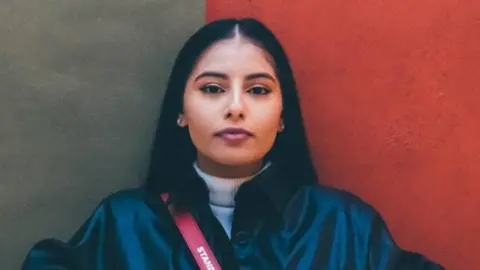Indo-Caribbeans in the UK: 'Our stories are yet to be heard'
 @halu_halo
@halu_halo Jana Ally struggled to fit in with the British Asian community around her when she was younger.
Her parents took her to an Indian dance class because they wanted her "to have something where I can relate back to my culture".
But 25-year-old Jana says she couldn't relate because she isn't Indian.
She's Indo-Caribbean, part of a community that came to the UK as part of the Windrush generation.
They've built a bright, vibrant culture since, but tell BBC Asian Network their stories aren't often heard and not many people know about them.
The UK census has no classification for "Indo-Caribbean" - like it does "Black Caribbean" for example - meaning no-one knows the exact population figures.
The closest classification is "Asian other", which is something that Jana says hasn't been helpful growing up.
"It just really made me feel like I was other, it made me feel like I was invisible and overlooked," she says.
"I look like I am South Asian, even if just half, and so I just started to fit into that box."
 Sanam Harrinanan
Sanam HarrinananJana, a designer who lives in London, says things like being taken to the dance class made her realise she was different to the girls around her.
"I sat there by myself and I was a lot lighter in skin tone than them so they could definitely tell I couldn't relate," she says.
"I didn't know the music, I didn't know the moves."
Sanam Harrinanan, who comes from a mix of Indian and Trinidadian heritage, won this winter's series of Love Island.
She says she received loads of comments when she was on the reality TV show - with people guessing where she was from.
"I don't think many people know about our heritage, they don't really know who we are," the 25-year-old says.
"I think as well when you're filling out your ethnicity on a form, it's not even an option. I'm always ticking other."
Sanam says growing up she didn't really pay too much attention to her heritage.
"I was born in Trinidad but moved to the UK when I was young," she says.
"Only recently, now I'm more public, I've paid attention."
 Bilal Ally
Bilal AllyBilal Ally lives in Leeds but his family heritage traces back to Guyana.
The 22-year-old writer and musician is trying to spread more knowledge and awareness of Indo-Caribbean culture through his music.
But he thinks public figures and celebrities like Sanam can help the community become more visible.
"There are so many [celebs] that are actually part Guyanese or Trinidadian and it's in the fifth line of their bio," he says.
"When I found out [musician] Loyle Carner is Guyanese I was like 'that is amazing' because it felt like that was someone like me out there who's actually doing something.
"It helps remove the feeling I had growing up and still have, that identity crisis that I'm sure many Indo-Caribbeans have."
The Indo-Caribbean community was born almost 200 years ago when slavery was abolished.
British land owners transported hundreds of thousands of people from India to work on their Caribbean plantations.
Many people then came to the UK 75 years ago when the ship HMT Empire Windrush and its 492 passengers from the Caribbean arrived in the UK.
"We are always omitted from this story," says historian Maria Kaladeen, who's an expert on Indo-Caribbean culture.
"It's only very recently that people have begun to include the stories of people who are Indian Caribbean in their Windrush narratives.
"And our stories are so similar to those of African Caribbean people who came to the UK during that period."
 Getty Images
Getty ImagesSo if Indo-Caribbean culture is a fusion of two places on opposite sides of the world - what makes it stand out as different from them both?
"The food," Sanam says without stopping for a breath.
"In Trinidad the food is a mixture of Indian and Caribbean and it's amazing. The one I'm in love with is a street food called doubles."
Jana is also a fan of doubles - fried flatbreads with a spicy chickpea curry - but says there's another part of the culture she loves.
"I mean obviously the music too," she says, adding the feel-good tunes mean "you can't be sad".
"I just think everything about the culture is so unique. It's two cultures mixed together and it just creates more."
Listen to the full interviews on Asian Network News Presents on BBC Sounds.


